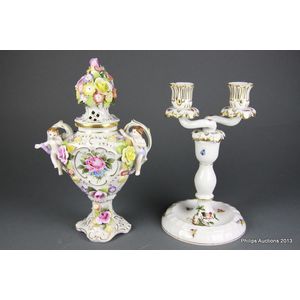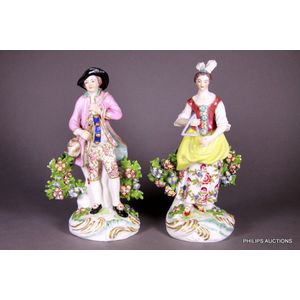Longton Hall Figural Candlestick
You must be a subscriber, and be logged in to view price and dealer details.
Subscribe Now to view actual auction price for this item
When you subscribe, you have the option of setting the currency in which to display prices to $Au, $US, $NZ or Stg.
- Attributed - A cataloguing term where the item in the opinion of the cataloguers, is a of the period of the artist, craftsman or designer, and which probably in whole or part is the work of that person.
- Circa - A Latin term meaning 'about', often used in the antique trade to give an approximate date for the piece, usually considered to be five years on either side of the circa year. Thus, circa 1900 means the piece was made about 1900, probably between 1895 and 1905. The expression is sometimes abbreviated to c.1900.
- Soft Paste Porcelain - Porcelain is an ancient ceramic material, first made in China, hence the common name "china", and the process was unknown in the West.
European potters attempted to replicate Chinese porcelain, without knowing the ingredients in its composition, and the earliest wares were produced with mixtures of clay and ground-up glass (frit), the idea being that the glass would give the porcelain translucency.
It was given the name "soft" because it did not remain rigid, but "slumped" when fired in the kiln at high temperatures. - Putto / Putti / Amorino / Amorini - A putto (plural: putti) or amerino (plural: amerini) is a cherub or cupid frequently appearing in both mythological and religious paintings and sculpture, especially of the Renaissance and Baroque periods and later used as a decorative element in the design of furniture, ceramics, statuary etc. They are usually depicted as chubby males, or of indeterminate gender, often with wings. Their depiction may represent an association with love, heaven, peace or prosperity.
This item has been included into following indexes:
Visually similar items

A Chelsea soft paste porcelain shepherdess figure, circa 1765, gold anchor period, the shepherdess in a mint green jacket, and a floral on salmon skirt, holding an abundance of flowers in her apron and a nosegay in her left hand, with a small bocage and a

A Meissen flower seller figure from 'The Cries of Paris', circa 1780, after the 1740s model by Peter Reinicke, the seller in a green bodice and striped skirt a basket across her left arm and balancing a basket of flowers on her head, blue crossed marks und

A German porcelain covered vase and a candelabrum, the vase Porzellan Manufaktur Plaue (Pmp), Thuringia, the candelabrum Herend, Hungary, the vase in the eighteenth century manner, decorated with painted and applied flowers and a pair of putti, the candela

A pair of Chelsea musician figures, circa 1756-69, gold anchor period, an elegant pair, she with a plumed head piece, a floral skirt and lemon apron and playing a triangle, and he with brimmed hat, in a pink coat and floral breeches playing a tambourine, b
